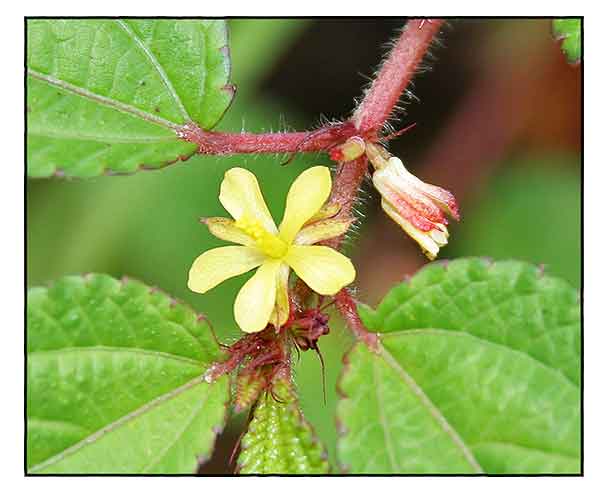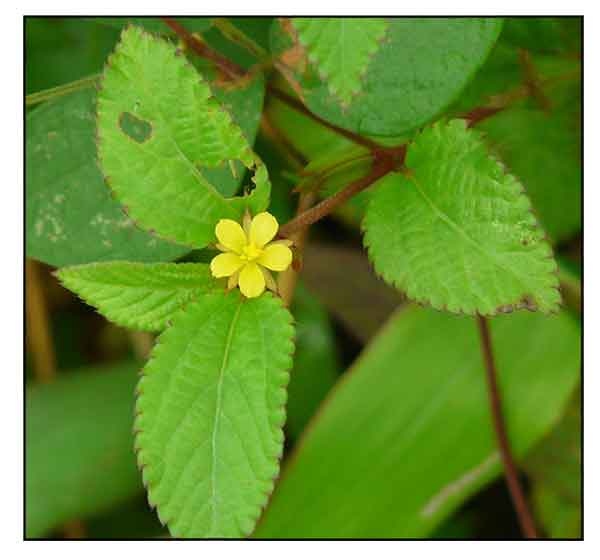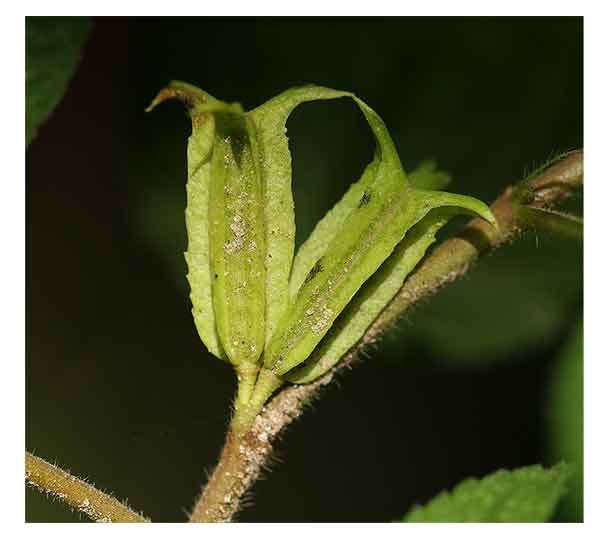 Gen info Gen info
- Corchorus is a genus of about 40-100 species of flowering plants in the Malvaceae family. The genus is classified under the subfamily Grewioideae.
- The genus Corchorus was first described by Linnaeus in his 1753 work Species Plantarum .
-
Jute is a shared common name applying to the fiber produced from the plant, and jute mallow leaves for the leaves used as vegetable.
(9)
- Plants sharing the common name jute are: Corchorus capsularis (white jute), C. olitorius (tossa jute)
, C. aestuans (jute).
Botany
Corchorus aestuans is a variable, procumbent, ascending or erect, often much-branched herb, up to 1 m tall, sometimes becoming woody at base. Branches terete with sparse to dense indumentum of straight, stiff, ascending hairs and of curly hairs. Leaves ovate to elliptical, 2-9 cm × 1-4 cm, pubescent. Inflorescence a lateral, solitary, 1-3-flowered cyme at nodes; pedicel up to 2 mm long, erect in fruit; sepals 5, linear, 3-3.5 mm long; petals 5, 3-4 mm long, clawed; stamens 9-14; ovary 3-4-celled with 16-22 ovules per cell, style 1 mm long, stigma fimbriate. Fruit a 3-4-angular, cylindrical capsule, 13-30 mm × 3-7 mm, 6-8-winged, 3-4-valvate, at apex with 3-4 bifid horns 4-5 mm long, many-seeded. Seed rhomboid-cylindrical, 1.5 mm long, brown to black. (1)
Distribution
- Native to the Philippines.
- Also native to Assam, Bangladesh, China, Himalaya, India, Laos, Malawi, Malaya, Myanmar, Nansei-shoto, Nepal, Pakistan, Queensland, Sri Lanka, Sulawesi, Taiwan, Thailand, Vietnam, etc.
(2)
- From sea level to 2,000 m altitude.
 Constituents Constituents
- Preliminary phytochemical study of various extracts of leaves yielded phenolic compounds, flavonoids, glycosides, carbohydrates, proteins, amino acids, saponins, phytosterols, triterpenoids, cardiac glycosides and tannins. (4)
-
Seeds contain 22.6% protein and 8.3-12.8% oil. Amino acids include valine, lysine, serine, aspartic acid, threonine and phenylalanine. Oil contains ß-sitosterol and fatty acids (palmitic acid, stearic acid, oleic acid, and linolenic acid). Seeds also contain corchorine, a glycoside of the stropanthine group, and quercetin, a flavonoid; cardenolides, ß-sitosterol, cery alcohol, oligosaccharides. Capsule extract yielded ß-sitosterol, lupeol, betulin, 2-methyl anthraquinone, scopoletin, and corchoroside-A. (4)
- Nutritional analysis of leaves yielded protein 3.7%, ß-carotene 76.33 mg/kg, iron 184.07 mg/kg, and potassium 4000 mg/'kg.
Leaf extract yielded fusidic acid together with ß-sitosterol, 2-methylanthraquinone and coumarin (scopoletin). (4)
- GC-MS analysis of ethanol extract isolated 14 different bioactive constituents, namely: 3,7 ,11,15-tetramethyl-2-hexadecen-1-ol (5.6%), Trans-2-undecen -1-ol (1.26%), E-7-Tetradecenol (1.97 %), n-Hexadecanoic acid (25.82%), Phytol (22.34%), 9,12,15 -octadecatrienoic acid, methyl ester, ( Z,Z,Z)- (20.23%), Docosanoic acid, ethyl ester (1.99%), 1-Eicosanol (2.11 %), 9,9-dimethoxybicyclo[3.3.1] nona-2,4-dione (0.60%), Heptadecanoic acid, heptadecylester (0.95%), Pentadecanoic acid,2,6,10,14-tetramethyl-methylester (0.91%), 3-Hexa decycloxycarbonyl-5-(2-hydroxyethyl)-4-methylimidazolium ion (0.90%), Squalene (8 .03%) and Vitamin E (7.24 %). (10)
- Qualitative screening of plant extracts yielded tannin, phenolic, saponin, alkaloid, flavonoid, trypsin, glycoside and carbohydrates, with absence of steroids, cardiac glycosides, and triterpenes.
- Quantitative analysis of leaves yielded alkaloid and flavonoid with highest mean value of 2.973 and 0.131 mg/kg, respectively, followed by carbohydrates 0.99 mg/kg and phenolics with 0.01 mg/kg. Vitamin C was highest at 8.82 mg/100g, followed by Vitamins E, A, and D at 5.68, 2.246 and 0.27 mg/100 g, respectively. (5)
- GC-MS analysis of ethanol extract of leaves
Properties
- Studies have suggested antibacterial, antioxidant, antiatherosclerotic, hypolipidemic, antioxidant properties.
Parts used
Leaves, aerial parts.
 Uses Uses
Edibility
- Leaves are edible, raw or cooked, eaten in salads, used as vegetable or potherb; exudes a large amount of mucilage on cooking. (1)
Folkloric
- In the Philippines, medicinal uses are similar to C. capsularis. Leaves are used for headaches, sprains, inflammation, fever, dysuria, and constipation; seed powder or decoction used as tonic, carminative, and febrifuge.
- In India, seeds used for the treatment of stomach ache and pneumonia and as anti-inflammatory.
- In African traditional medicine, roots or leaves used for treatment of gonorrhea. Plant or root extracts used for injections for urethral discharges. In DR Congo, leaf sap sniffed for treatment of headache. (1)
Others
- Fiber: Bast fiber used for making threat and string. Fiber considered good, but strength is lower than Corchorus capsularis and C. olitorius, and is of secondary importance in the industrial jute fiber production. (1)
- Taboos: In some African tribes, there are some taboos on the plant. The Quatchi communities in Togo prohibit its consumption. (1)
- Cosmetics: Leaf extracts used as moisturizers in skin cosmetics.
- Fodder: Foliage is browsed by all livestock. (1)
Studies
• Silver Nanoparticles / Antibacterial / Leaves: Study reports on an eco-friendly synthesis of silver nanoparticles using leaf extract of C. aestuans. The AgNPs showed efficient antibacterial activity more toward Gram-negative than Gram-positive bacteria. (3)
• Acute Toxicity Study / Leaves: Study evaluated the acute toxicity of Corchorus aestuans and C. olitorius in mice gorging on increasing doses of crude aqueous extract. Corchorus aestuans showed an LD50 of 3999.93 mg/kg. The phytomedicine in the conditions and dosage used in traditional medicine is considered not toxic. (6)
• Benefits in Ulcerative Colitis / Antioxidant / Aerial Parts: Study evaluated the effect of ethanolic extract of aerial parts of C. aestuans in Dextran Sulfate Sodium (DSS)-induced colitis in rats. The extract significantly and dose-dependently decrease the disease activity index and colon weight. DDS induced colitis significantly elevated MPO activity, while extract administration significantly inhibited MPO activity in rats The extract restored the antioxidant parameters to normal level suggesting potent antioxidant activity of the extract. Results suggest the improved condition of ulcerative colitis may be due to enhancement of tissue antioxidant levels. (7)
• Antiatherosclerotic / Hypolipidemic / Leaves: Study evaluated an ethanolic extract of leaves for antiatherosclerotic and hypolipidemic properties against high fat diet induced atherosclerosis in male
Wistar rats. The extract significantly decreased levels of TC, TG, LDL, VLDL and atherogeniic index, and significantly increased HDL levels in a dose dependent manner. Results suggest antiatherosclerotic and hypolipidemic effects with potential benefit in the management of hyperlipidemia and atherosclerosis.
(8)
• Antioxidant / Flavonoids / Leaves: Preliminary phytochemical study of various extracts of leaves yielded flavonoids, carbohydrates, saponins, phytosterols, phenolic compounds, triterpenoids, cardiac glycosides and tannins. Study evaluated the isolated flavonoids and their antioxidant potential. Scavenging activity on DPPH radicals and radical scavenging activity by EDTA established the antioxidant potency of C. aestuans. (11)
Availability
Wild-crafted.
|

![]()






